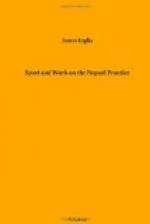At some of the Pooneahs the evening’s gaiety winds up with a nautch or dance, by dancing girls or boys. I always thought this a most sleep-inspiring exhibition. It has been so often described that I need not trouble my readers with it. The women are gaily dressed in brocades and gauzy textures, and glitter with spangles and tawdry ornaments. The musical accompaniment of clanging zither, asthmatic fiddle, timber-toned drum, clanging cymbal, and harsh metallic triangle, is a sore affliction, and when the dusky prima donna throws back her head, extends her chest, gets up to her high note, with her hand behind her ear, and her poura-stained mouth and teeth wide expanded like the jaws of a fangless wolf, and the demoniac instruments and performers redouble their din, the noise is something too dreadful to experience often. The native women sit mute and hushed, seeming to like it. I have heard it said that the Germans eat ants. Finlanders relish penny candles. The Nepaulese gourmandise on putrid fish. I am fond of mouldy cheese, and organ-grinders are an object of affection with some of our home community. I know that the general run of natives delight in a nautch. Tastes differ, but to me it is an inexplicable phenomenon.
Amid all this noise we sit till we are wearied. Parin-leaves and betel nut are handed round by the servants. There is a very sudorific odour from the crowd. All are comfortably seated on the ground. The torches flare, and send up volumes of smoke to the ornamented roof of the canopy. The lights are reflected in the deep glassy bosom of the silent tank. The combined sounds and odours get oppressive, and we are glad to get back to the bungalow, to consume our ‘peg’ and our ‘weed’ in the congenial company of our friends.
In some factories the night closes with a grand dance by all the inhabitants of the dangur tola. The men and women range themselves in two semicircles, standing opposite each other. The tallest of both lines at the one end, diminishing away at the other extremity to the children and little ones who can scarcely toddle. They have a wild, plaintive song, with swelling cadences and abrupt stops. They go through an extraordinary variety of evolutions, stamping with one foot and keeping perfect time. They sway their bodies, revolve, march, and countermarch, the men sometimes opening their ranks, and the women going through, and vice versa. They turn round like the winding convolutions of a shell, increase their pace as the song waxes quick and shrill, get excited, and finish off with a resounding stamp of the foot, and a guttural cry which seems to exhaust all the breath left in their bodies. The men then get some liquor, and the women a small money present. If the sahib is very liberal he gives them a pig on which to feast, and the dangurs go away very happy and contented. Their dance is not unlike the corroborry of the Australian aborigines. The two races are not unlike each other too in feature, although I cannot think that they are in any way connected.




